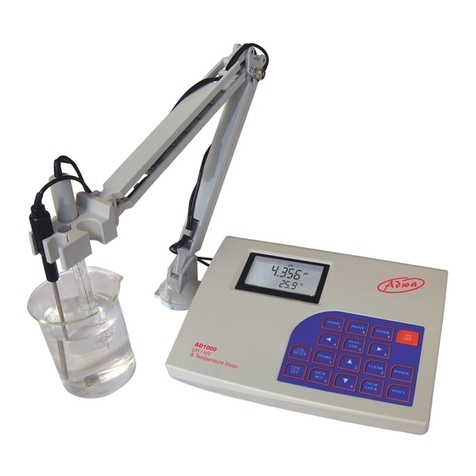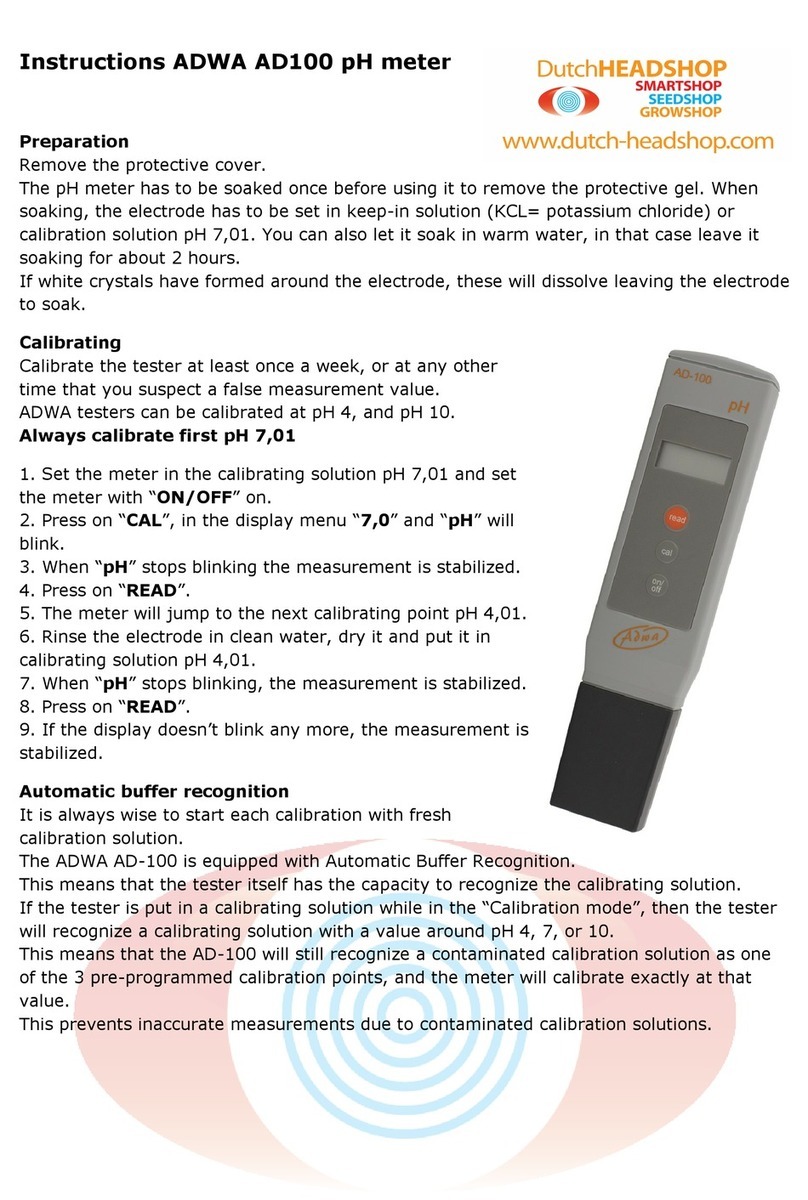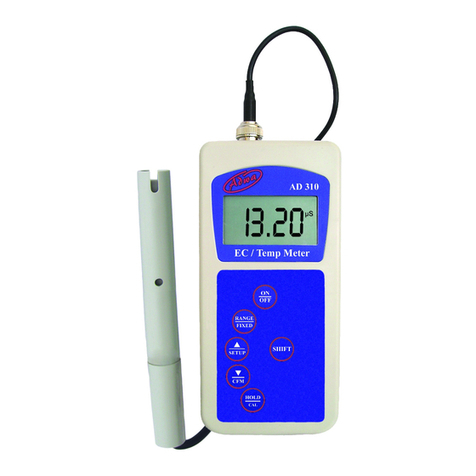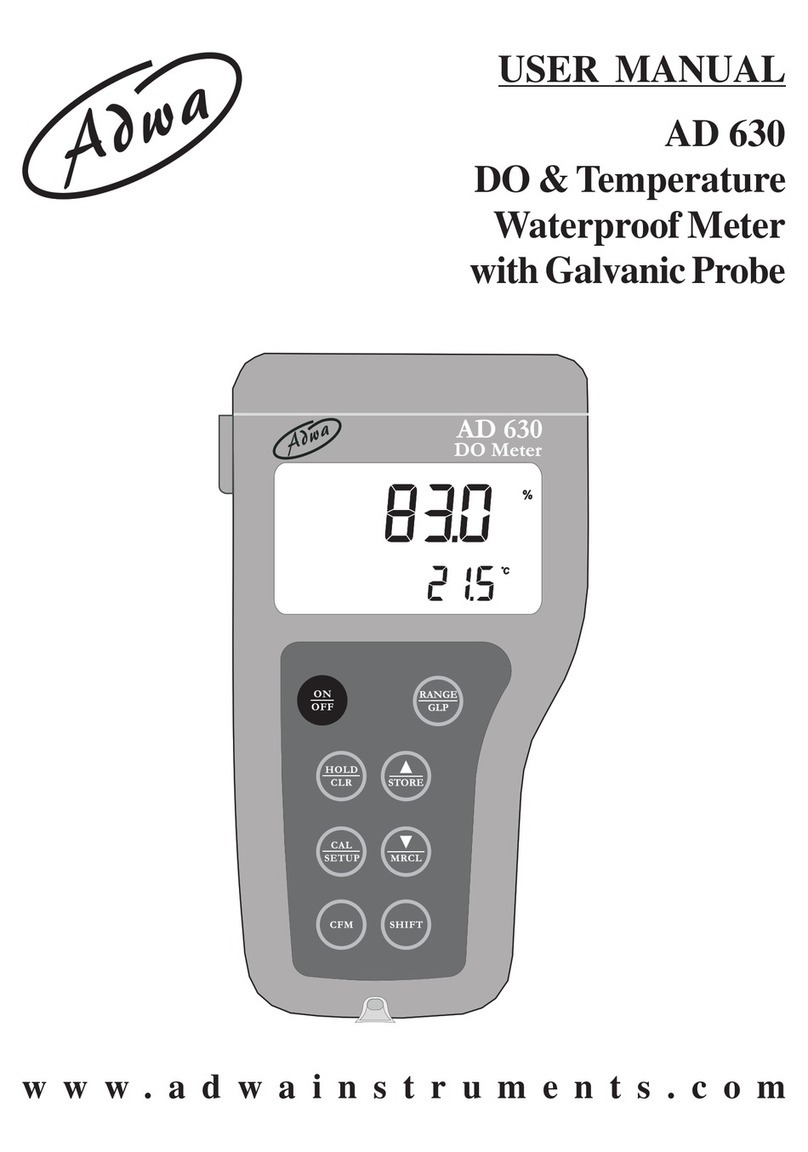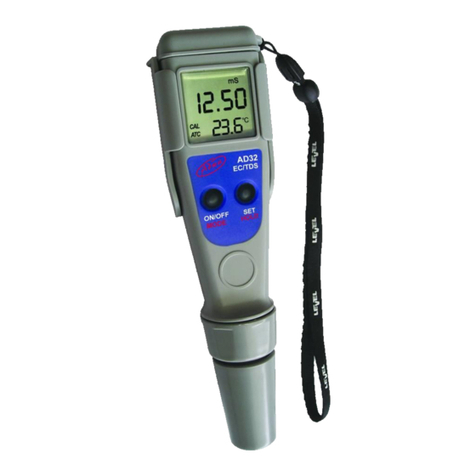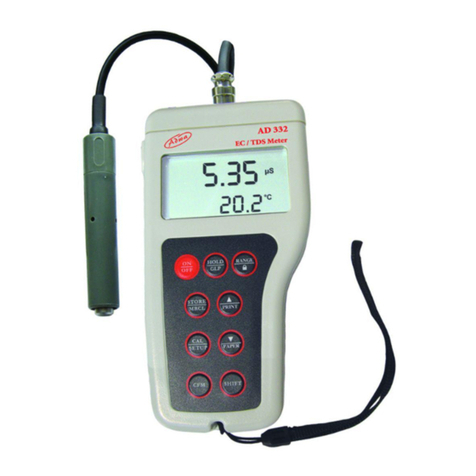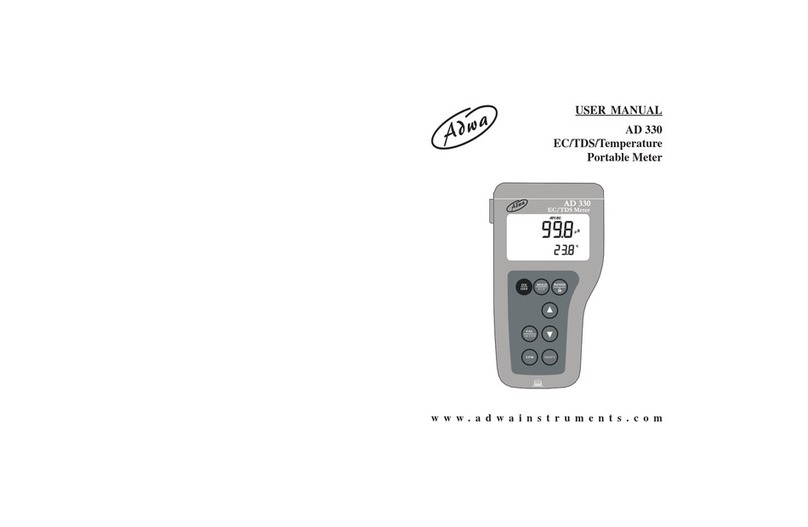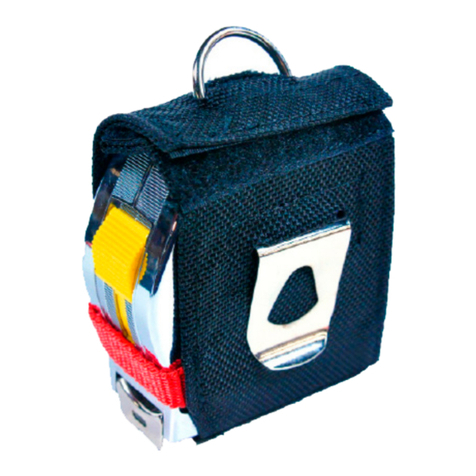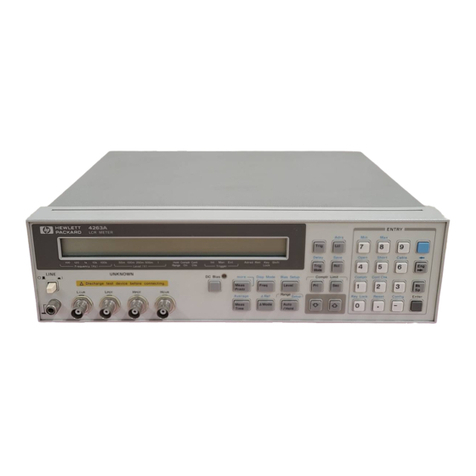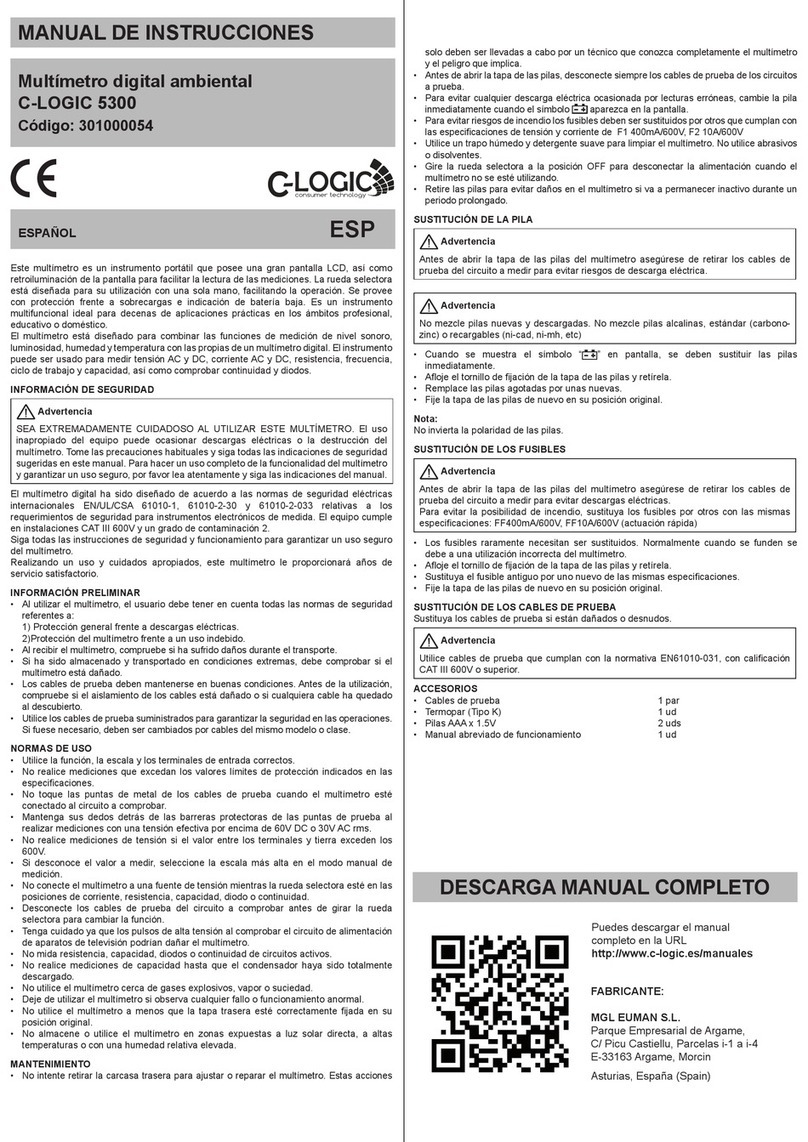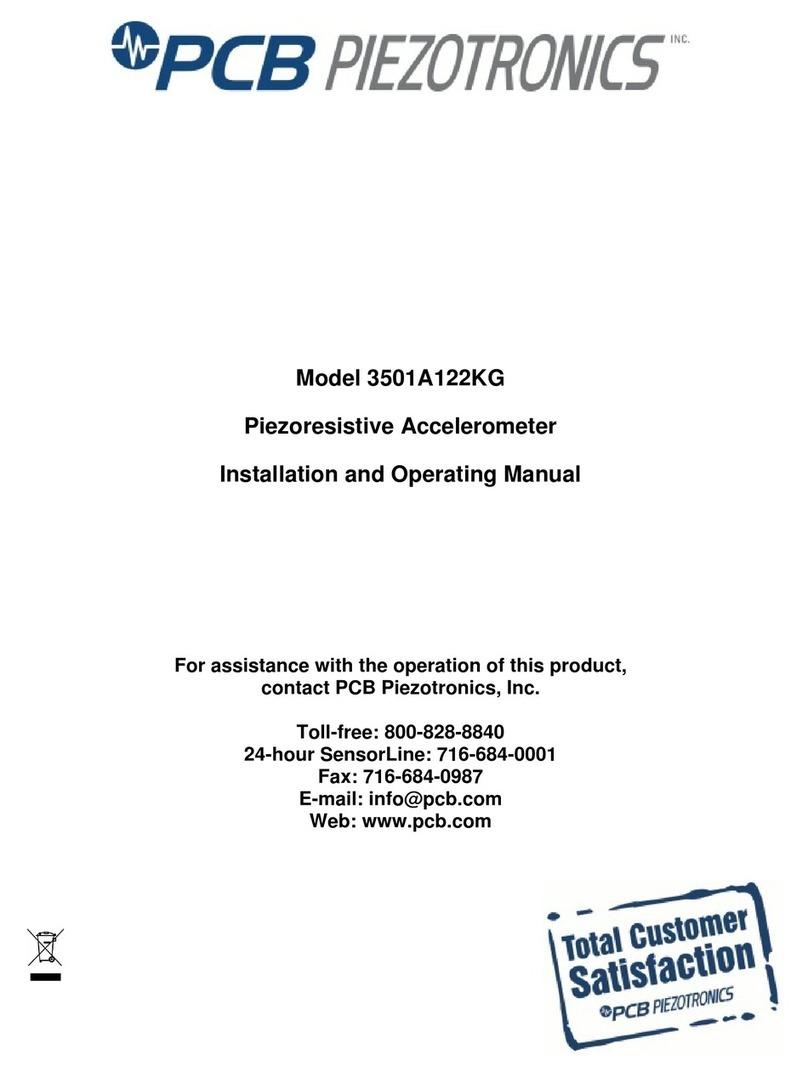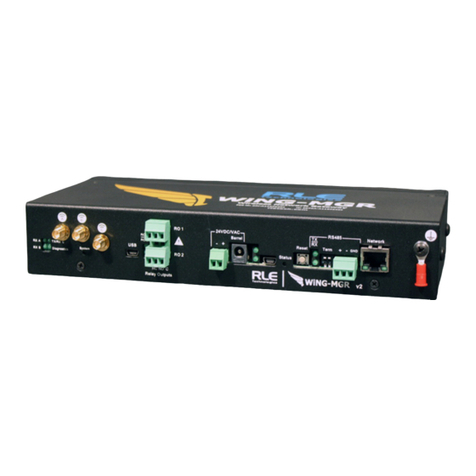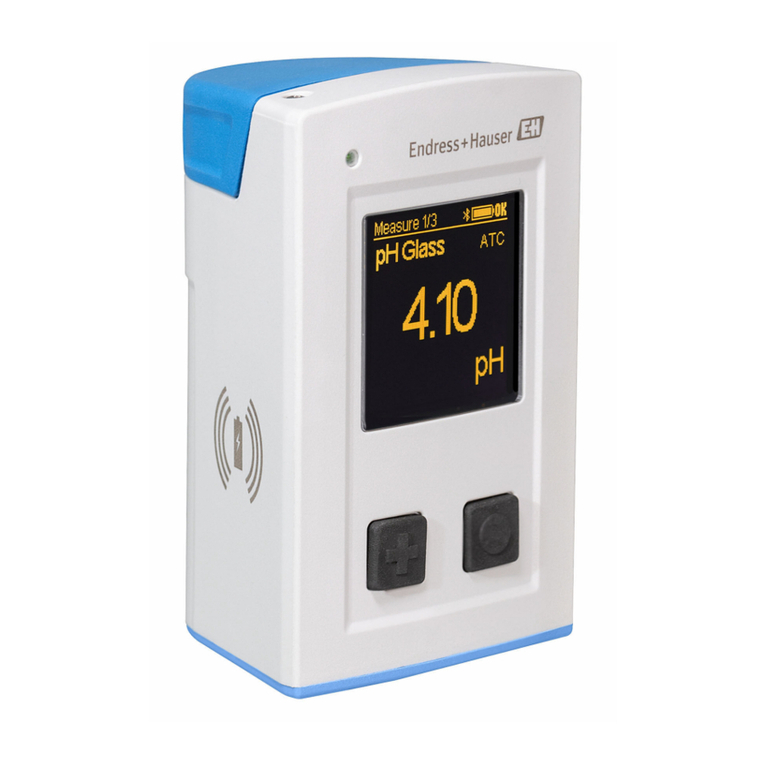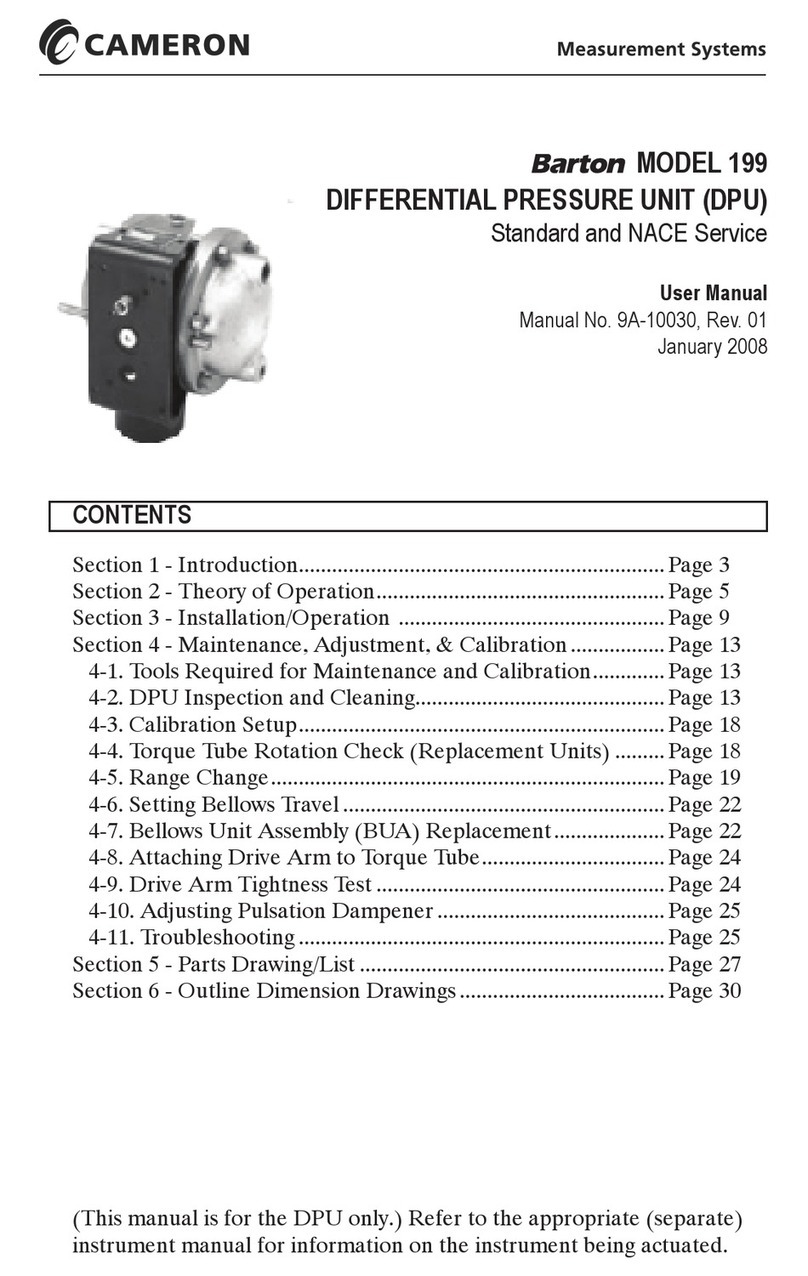ADWA AD 3000 User manual

USER MANUAL
AD 3000
EC/TDS/Temperature
Bench Meter
www.adwainstruments.com
MANAD3000R3 06/09
ADWA INSTRUMENTS Kft.
Alsókikötõ sor 11, 6726 Szeged, Hungary
Tel. +36 62 317 878
Fax +36 62 550 610
e-mail: [email protected]
www.adwainstruments.com

Dear Customer,
Thank you for choosing an Adwa product. Please read
carefully this manual before starting operations. This
instrument is in compliance with the EMC Directive 89/
336/EEC and Low Voltage Directive 73/23/EEC for
electrical equipments. For more technical information,
WARRANTY
Adwa warrants this product to be free of defects in material
and workmanship as stated in the operating manual. If repair
or adjustment is necessary and has not been the result of
abuse, misuse or improper handling within the warranty pe-
riod,pleasecontactyourdealerorthenearestAdwaOfficefor
the RGA (Return Goods Authorization) number to put on the
outsideofyourpackage.Warrantedservicewillbe made with-
out charge. The meter is warranted for a period of 2 years,
while probes are warranted for 6 months. The warranty pe-
riod commences from the original date of sale. Warranty is
only valid when the product is used under normal conditions
and in accordance with the instruction manual. The warranty
is void if the instrument is repaired or serviced by unautho-
rizedpersonnel,notusedinaccordancetothe instructions, or
if non-Adwa accessories such as buffer solutions, probes,
etc. are used in conjunction with the meter. Adwa will not be
held responsible for any accident whether directly or indi-
rectly, caused by the use of this instrument.
35
PROBES AND SOLUTIONS
A76309 Conductivity probe with built-in tem-
perature sensor and 1 m cable
A70031P 1413 µS/cm solution, 20 ml sachet, 25
pcs
A70030P 12.88 mS/cm solution, 20 ml sachet, 25
pcs
A70032P 1382 ppm solution, 20 ml sachet, 25 pcs

3
Introduction........................................................... 4
Technical Data ..................................................... 6
Front and Rear Panels .......................................... 8
Operational Guide ................................................10
Autoranging .........................................................13
Temperature Compensation ..................................14
EC Calibration .....................................................16
Temperature Adjustment ......................................21
Setup ...................................................................22
Good Laboratory Practice ....................................25
Log-on-demand ....................................................29
Hold ....................................................................33
Probe Maintenance ..............................................34
Probes and Solutions ............................................35
TABLE OF CONTENTS
34
PROBE MAINTENANCE
After measurements, rinse the probe with clean water.
If a more thorough cleaning is required, remove the probe
sleeve and clean the probe with a cloth or a non-abra-
sive detergent.
Make sure to reinsert the sleeve onto the probe properly
and in the right direction.
After cleaning the probe, recalibrate the instrument.

4
AD3000 is a bench microprocessor-based conductivity,
TDS and temperature meter.
The autoranging feature of the EC and TDS ranges
automatically sets the instrument to the scale with the
highest resolution.
Measurements are compensated for temperature ef-
fect automatically (ATC) or manually (MTC) with the
conductivity probe with built-in temperature sensor. It
is also possible to disable the temperature compensa-
tion and measure the actual conductivity.
The temperature coefficient is user selectable.
The instrument is equipped with a stability indicator, to
indicate when measurement is to be recorded.
AD3000 includes also GLP capability.
In addition, the meter allows the user to enter an ID
code to uniquely identify the instrument.
INTRODUCTION
33
Note: Press SHIFT+HOLD keys to escape without
deleting data.
If no samples are stored in memory and a dele-
tion is attempted, the meter shows the "Zero"
message and then returns to measurement mode.
To freeze the first stable reading on
the LCD, press the HOLD key from
measurement mode.
The "Auto" and " H" tags will blink on the LCD until the
reading is stabilized.
When the reading becomes stable, the "Auto" and "H"
tags stop blinking and the reading is frozen.
Press the HOLD key again to return the normal mea-
surement mode.
HOLD

5
This model is supplied complete with:
•A76309 conductivity probe with built-in temperature
sensor and 1 m cable
•Calibration solutions at 1413 µS/cm and 12.88 mS/cm
and 111.8 mS/cm (20 ml sachet each)
•12 Vdc power adapter
•Probe holder
•User manual
32
TO DELETE STORED DATA
The meter allows to delete a single sample or all the
memory at one time.
To delete a single sample proceed as follows:
•Enter the viewing stored data mode and select the de-
sired sample number.
•Press the HOLD key. "dEL" and
"CFM" will start blinking.
•Press CFM to confirm deletion.
Note: Press HOLD key again to escape without de-
leting data. When scrolling through stored data,
if a deleted sample is selected, the meter will
display the "nuLL" message.
To delete all data in memory:
•Enter the viewing stored data mode.
•Press SHIFT+HOLD keys. "dEL" and "CFM" will start
blinking and the "ALL" message is displayed on the
secondary LCD.
•Press CFM to confirm
deletion.

6
TECHNICAL DATA
Range 0.00 to 19.99 µS/cm; 0.00 to 9.99 ppm
20.0 to 199.9 µS/cm;
10.0 to 99.9 ppm 200
to 1999 µS/cm; 100 to 999 ppm 2.00
to 19.99 mS/cm; 1.00 to 9.99 ppt
20.0 to 199.9 mS/cm; 10.0 to 99.9 ppt
-9.9 to 120.0°C
Resolution 0.01, 0.1, 1 µS/cm; ppm
0.01, 0.1 mS/cm; ppt
0.1°C
Accuracy ±1% f.s. (EC/TDS)
(@20°C/68°F) ±0.5°C
EC Calibration Offset at 0.00 µS/cm;
Slope at 1 point
with 6 memorized values
(84.0, 1413 µS/cm; 5.00, 12.88, 80.0, 111.8 mS/cm)
or with custom value
Temperature Automatic or manual,
Compensation -9.9 to 120°C
Temperature Selectable
Coefficient from 0.00 to 10.00%/°C
TDS Factor Selectable from 0.40 to 1.00
(default value: 0.50)
31
•time
•EC or TDS reading
(only dashes "----" means
reading out of range or
probe not connected)
•Temperature reading
(only dashes "----" means
reading out of range)
•To skip to the next or previous sample, use the up or
down arrow keys respectively.
For example, if the up arrow key is pressed while a
sample reading is displayed, the meter shows the read-
ing of next sample.
•To return to normal measurement mode, press the
SHIFT+RECALL keys at any time.

7
Reference Temperature
Selectable from 15.0 to 30.0°C
Log-on-demand Up to 250 samples
Probe (included) A76309 EC probe
with built-in temperature sensor
Power Supply 12 Vdc power adapter
Environment 0 to 50°C
RH max 95% non-
condensing
Dimensions 230 x 180 x 50 mm
Weight 1.8 kg
30
TO VIEW STORED DATA
To retrieve the memorized infor-
mation, press SHIFT+RECALL
keys.
The primary LCD displays the date (day and month)
and the secondary LCD shows the last stored sample
number.
If no samples are stored into memory, the "ZERO" indi-
cation is displayed.
•Select the desired sample number using the arrow keys.
If the up arrow key is pressed while the last sample is
displayed, the meter returns to the first sample.
•Press RANGE to view the remain-
ing data for the selected sample in
the following order:
•year

8
Front Panel
Rear Panel
FRONT AND REAR PANEL
29
LOG-ON-DEMAND
To store the current reading into
memory, press STORE key while in
measurement mode.
The LCD will display for a few seconds the "Stor" mes-
sage together with the "LOG" tag and the sample num-
ber.
By pressing the STORE key a complete set of informa-
tion is memorized: date, time, EC, TDS and temperature
readings.
Up to 250 samples can be stored into memory.
When the memory is full and
the STORE key is pressed,
the sample will not be stored
and the LCD will display the
"FULL" message.
In this case, it is necessary to delete all data from memory
to proceed.

9
1. Liquid Crystal Display (LCD)
2. STORE/RECALLkey, to store measurements and
recall stored data
3. CFM key, to confirm values
4. CAL key, to enter/exit calibration mode
5. Up arrow key, to manually increase the value of
temperature or other parameters
6. Down arrowkey, to manually decrease the value of
temperature or other parameters
7. SHIFT key, to activate the key alternate function.
Press and hold first the SHIFT key and then the
second desired key
8. SETUP key, to enter/exit setup mode
9. RANGE/”lock” key, to select measurement unit
or switch the focused data, and to freeze current
range on the LCD
10. ON/OFF key, to turn the instrument ON and OFF
11. HOLD/GLP key, to freeze the first stable reading
on the LCD and to display Good Laboratory Prac-
tice information
12. Power supply socket
13. Probe connector
28
If RANGE is pressed when the last parameter is dis-
played, the meter returns to measurement mode.
Notes:
•To exit GLP mode at any time press SHIFT+GLP keys.
•If the calibration procedure was never performed, af-
ter displaying the ID code, the LCD will show the "no
CAL" message blinking. Press RANGE or
SHIFT+GLP keys to return to measurement mode.
•Last calibration data is available for EC range only.
No calibration data can be recalled for TDS. If the
meter is in TDS mode, by pressing SHIFT+GLP keys
only the ID code is shown. Press SHIFT+GLP keys
again to return to measurement mode.
•The meter is provided with an internal lithium battery
that allows to correctly update date and time even if
the power supply is disconnected.
•GLP data are not affected by the zero calibration.

10
CONNECTIONS
•Plug the 12 Vdc adapter into the power supply socket.
Note: These instruments use non volatile memory to
retain the calibration parameters and all other
settings even when unplugged.
•Connect the probe to the 7-pin connector. Tighten the
threaded ring and make sure the probe sleeve is prop-
erly inserted, as shown below:
INSTRUMENT START-UP
•Turn the instrument on by pressing
the ON/OFF button.
•All LCD tags are displayed and a
beep is generated while the instru-
ment performs a self test.
OPERATIONAL GUIDE
27
Cell constant value (K):
If standard calibration solution was used:
If custom calibration solution was used:
If the cell constant was changed after calibration (through
the "CELL" setup function), this information is not dis-
played.

11
TAKING MEASUREMENTS
•Immerse the probe into the solu-
tion to be tested. The sleeve holes
must be completely submerged.
•Tapthe probe repeatedly to remove
any air bubbles that may be trapped
inside the sleeve.
•If needed, press RANGE until the
desired EC or TDS range is se-
lected on the LCD.
•Allow for the reading to stabilize. The primary LCD
displays the measurement in the selected range, while
the temperature is displayed on the secondary LCD.
26
Last calibration date (day and month):
Last calibration date (year):
Last calibration time:

12
Notes:
•If the meter displays only dashes "----", the read-
ing is out of range.
•If the stability indicator (hourglass symbol) blinks,
the reading is not stable.
•Make sure the meter is calibrated before taking
measurements.
•If measurements are taken successively in dif-
ferent samples, for accurate reading it is recom-
mended to rinse the probe thoroughly with deion-
ized water before immersing it into the sample.
•TDS reading is obtained by multiplying the EC
reading by the TDS factor, which has a default
value of 0.50. It is possible to change the TDS
factor within the 0.40 to 1.00 range by entering
setup mode and selecting the "tdS" item (see
“Setup” section for details).
25
GOOD LABORATORY PRACTICE
Good Laboratory Practice (GLP) is a set of functions
that allows storage and retrieval of data regarding the
status of the system.
After a successful calibration, the meter automatically
stores the date and time of calibration, the used calibra-
tion solution and the resulting cell constant value.
All this information can be recalled by the user.
To view the last calibration data,
press SHIFT and GLP keys. The
first information appearing on the
LCD is the meter "id" code.
By repeatedly pressing RANGE key,
all GLP data are displayed as shown
in the next pages.

13
AUTORANGING
The EC and TDS scales are autoranging. The meter
automatically sets the scale with the highest possible
resolution.
By pressing SHIFT and ”lock”
keys,the autoranging feature is dis-
abled and the current range is fro-
zen on the LCD.
The µS, mS, ppm or ppt tag (de-
pending on the selected measure-
ment mode and range) starts blink-
ing.
To restore the autoranging option press the SHIFT and
”lock” keys again.
Note: Autoranging is automatically restored if range is
changed, if setup or calibration mode is entered,
or if meter is turned off and back on again.
24
The following table lists the setup items, their valid range
and the factory settings (default):
Item
tc
tcE
rEF
tdS
CELL
bEEP
YEAr
DATE
TIME
id
vEr
Description
Temp.compensation coeff.
Temp.compensation mode
Reference temperature
TDS factor
Cell constant (K)
Beep on key pressed
Year
date (DD.MM)
Time (hh:mm)
Meter identification code
firmware release
Valid values Default
0.00to10.00%/ºC 1.90
Atc, Mtc, notc Atc
15.0 to 30.0 ºC 25.0 ºC
0.40 to 1.00 0.50
0.500 to 1.700 1.000
On, Off On
1999 to 2098
01.01 to 31.12
01:01 to 23:59
0000 to 9999 0000

14
TEMPERATURE COMPENSATION
Three options are available for temperature compen-
sation:
1. Automatic (ATC): the EC probe features a built-in
temperature sensor, which provides the temperature
reading to automatically compensate the EC/TDS
measurement (from -9.9 to 120.0°C), also using the
selected reference temperature.
2. Manual (MTC): the temperature value can be manu-
ally set using the arrow keys. The compensation is
referenced to the selected reference temperature.
While in MTC mode, the °C tag blinks on the second-
ary LCD.
3. No compensation (NOTC): the temperature is not
taken into account. The reading displayed on the pri-
mary LCD is the actual EC or TDS value.
Notes:
•The default compensation mode is ATC.
•Temperature compensation setting can be ac-
cessed by entering the setup mode and selecting
the "tcE" item (see “Setup” section for details).
23
Press the arrow keys to change the value.
If there is another part of the item to be set (e.g. month
in setting up the current date), press RANGE and the
part to be changed will start blinking.
Press the ARROW keys to change the value and CFM
to confirm.
Note: Press SETUP key before confirmation to escape
without changing the previously set value.

15
•If the temperature compensation is active, mea-
surements are compensated using the tempera-
ture coefficient (default value 1.90 %/°C).
To change the temperature coefficient, enter the
setup mode and select the “tc” item (see “Setup”
section for details).
•If the temperature reading is out of the -9.9 to
120.0°C interval and the ATC option is selected,
the temperature full scale value will be displayed,
together with the °C tag blinking. No tempera-
ture compensation will be performed.
•The reference temperature can be set from 15
to 30°C. When the reference temperature is
changed, the temperature coefficient must be
manually adjusted by the user.
For example, if ?is the coefficient with refer-
ence temperature of 25°C, if changing the tem-
perature to 20°C, the new coefficient can be cal-
culated with the following formula:
?=?/(1-?/20)
If ?=1.90%/°C, then ?=2.10%/°C.
•Always set reference temperature to 25°C
when measuring TDS.
22
SETUP
Setup mode allows to view and modify the instrument
parameters.
To enter setup mode, press SETUP key from measure-
ment mode. The SETUP tag lights up. The primary LCD
will display the temperature coefficient (default value
1.90%/ºC), while the secondary LCD shows the code
of the current setup item.
Select the desired setup item using the arrow keys, then
press CFM to select and edit the setup item value, and
its current value starts blinking (if it is a changeable pa-
rameter).

16
EC CALIBRATION
STANDARD CALIBRATION
EC calibration is a one-point procedure. Selectable cali-
bration points are: 0.00, 84.0 and 1413 µS/cm, 5.00, 12.88,
80.0 and 111.8 mS/cm.
•Rinse the probe with calibration so-
lution or deionized water, then im-
merse it into the solution. The sleeve
holes must be completely submerged.
•Tap the probe repeatedly to remove
any air bubbles that may be trapped
inside the sleeve.
•To enter EC calibration, select the
EC range and press CAL key.
Note: TDS readings are automatically derived from the
EC readings and no specific calibration for TDS
is needed. Pressing CAL when TDS range is
selected has no effect.
•For zero calibration, simply leave the dry probe in the
air. The "CAL" and "BUFFER" tags light up.
21
TEMPERATUREADJUSTMENT
The temperature reading can be manually fine-tuned fol-
lowing the next procedure.
Press SHIFT and CAL keys to en-
ter the temperature adjustment
mode. Both primary and secondary
LCDs will display the factory de-
fault temperature reading.
Adjust the temperature reading on the primary LCD using
the arrow keys. The maximum adjustment is ±1.0ºC
around current reading.
Press CFM to confirm. The meter returns to measure-
ment mode and displays the new temperature.
Notes:
•Press SHIFT and CAL keys to escape without
any changes.
•To enter temperature adjustment mode, the
probe must be connected and the meter must
be in ATC mode.

17
•The primary LCD displays the not calibrated EC read-
ing, while the secondary LCD shows one of the avail-
able standard values. The hourglass symbol blinks.
•If necessary, use the arrow keys to select the desired
standard value.
•When the reading is stable, the CFM tag starts blink-
ing. Press CFM to confirm calibration.
•The instrument displays the "Stor"and "Good"mes-
sages and returns to measurement mode.
20
Notes:
•Zero calibration is not allowed in custom mode.
•The calibrated custom value is considered the value
of the calibration solution at the selected reference
temperature.
•It is possible to set the cell constant value directly,
without following the calibration procedure. To set the
cell constant enter the setup mode and select the
"CELL" item (see “Setup” section for details).
•The temperature reading is not used during custom
EC calibration.

18
Notes:
•If the temperature is out of range, the "WRONG
BUFFER TEMP" message blinks on the LCD. If the
reading is too far from the expected value, "WRONG
BUFFER" blinks.
•For best results choose a standard value for calibra-
tion close to the sample to be measured.
•During standard calibration the meter uses 1.90%/°C
compensation coefficient . If the setup item "tc" has
been set to different value, when exiting calibration
mode, the displayed valued on the upper LCD might
be different from the nominal standard value.
CUSTOM CALIBRATION
It is also possible to perform EC calibration with custom
calibration solution.
•Immerse the probe in the custom calibration solution
and select the EC range. Press CAL to enter the EC
calibration and then the RANGE key to enter custom
EC calibration mode.
19
•The "CAL", "BUFFER" and "Cal Point Custom" tags
light up. The primary LCD displays the not calibrated
temperature compensated EC reading, while the sec-
ondary LCD shows the temperature compensated EC
reading, factory calibrated with k=1. The hourglass
symbol blinks.
•Using the arrow keys, adjust the EC reading on the
primary LCD to the desired value.
•The maximum adjustment is ± 40% around the sec-
ondary LCD reading.
•When the reading is stable, the CFM tag starts blink-
ing on the LCD. Press CFM to confirm calibration.
•The instrument displays the "Stor"and "Good"mes-
sages and returns to measurement mode.
Table of contents
Other ADWA Measuring Instrument manuals
Popular Measuring Instrument manuals by other brands

Magnet-physik
Magnet-physik FH 55 operating instructions

YOKOGAWA
YOKOGAWA PH72-21-E-AA user manual

iWave
iWave WF28 user manual
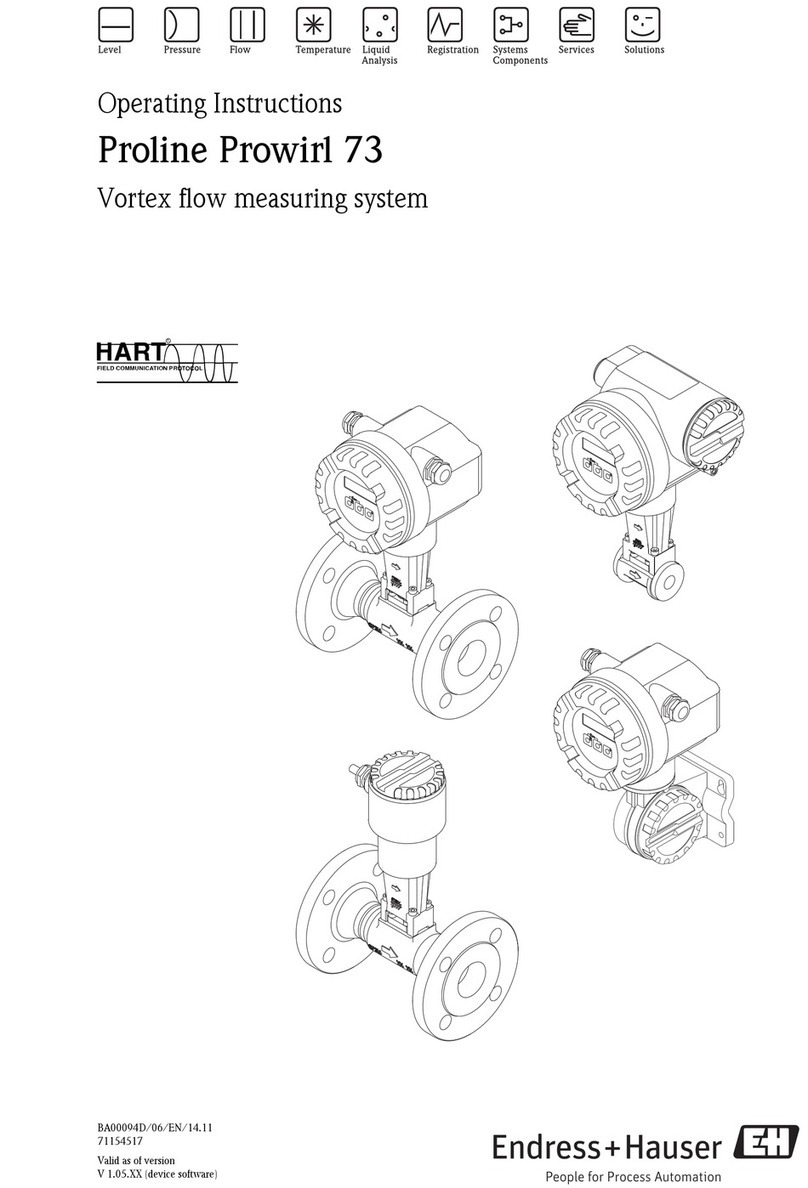
Endress+Hauser
Endress+Hauser Proline Prowirl 73 operating instructions

Leuze electronic
Leuze electronic AMS 3007i 40 manual
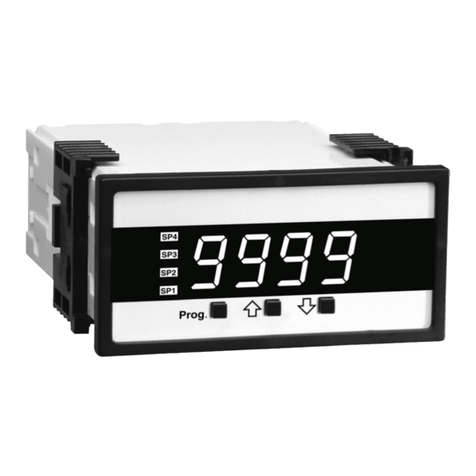
PCB Piezotronics
PCB Piezotronics IMI SENSORS 683A1 Installation and operating manual

